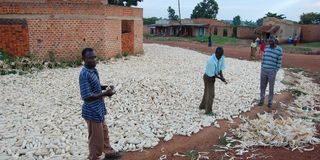Prime
How low-budget home meals pose grave risks

Men dry maize in Butebo District in 2014. New research conducted by a team of food technology and nutrition lecturers and researchers from Makerere University shows that about 1.85 million lower-income Kampala dwellers are unwittingly exposed to the dangers of toxins. photos/file
What you need to know:
Budget-strapped Ugandans are threatened by the consumption of food contaminated with aflatoxins, leaving them at a serious risk of liver cancer. As Deogratius Wamala writes, 1,860 lives were lost to liver cancer in 2020 alone.
New research conducted by a team of food technology and nutrition lecturers and researchers from Makerere University shows that about 1.85 million lower-income Kampala dwellers are unwittingly exposed to the dangers of toxins. The toxins, which are produced by certain fungi that are found in agricultural crops such as maize, peanuts, cottonseed, and tree nuts, are known as aflatoxins.
According to the UN World Urbanisation Prospects, Kampala has 3.7 million residents in its agglomeration city and nearby suburbs, many of whom subsist on less than a dollar per day.
For these budget-strapped families, survival depends on low-cost cereals and legumes for food. However, the very affordability that makes these foods a lifeline also exposes them to the peril of aflatoxins.
These foods, which have been found to particularly be maize and groundnuts, are mainly purchased from retail shops and open markets which expose them to mould and aflatoxin contamination.
The study shows that a limited budget forces families to ration their meagre earnings and buy this food only once or twice a week.
“These staple crops are mainly sourced from urban markets that do not have appropriate handling and storage systems, which expose them to unfavourable environmental conditions like rain and high humidity and insect infestation, which facilitate fungal growth and subsequent contamination with aflatoxins,” the researchers note.
Children at risk
Plastic containers, often used for storage due to their affordability, unwittingly become breeding grounds for aflatoxins, allowing these toxins to flourish within the stored grains and nuts. It has not helped matters that daily consumption of maize and groundnuts has reached alarming levels, particularly among children and mothers grappling with economic hardships.
Children, especially, are consuming alarming amounts—128.7 grammes of maize and 189.9 grammes of groundnuts per day. This surge is not a choice but a necessity driven by economic constraints, placing these vulnerable groups at the forefront of the aflatoxin crisis.
“The majority of the household heads were engaged in low-income occupations, with 35 percent earning less than $1 (Shs3,700) a day,” said the nutrition study.
Aflatoxins aren’t just a local concern, they are a global challenge. These hidden toxins have been linked to liver cancer in adults, stunted growth in children, and the insidious weakening of immune systems. In severe cases, they can lead to fatalities, as witnessed in the tragic events of the 2004 aflatoxin poisoning outbreak in Kenya.
Beyond health, aflatoxin contamination has far-reaching economic implications. In regions with stringent regulations, crops exceeding aflatoxin limits cannot be traded, leading to reduced incomes for farmers and traders.
The Sustainable Development Goals (SDGs) offer a blueprint for a better world, with food security, nutrition, and health as central tenets, particularly on the second and third SDGs.
Access to safe and nutritious food is crucial to achieving these goals. Regrettably, mycotoxins, most especially aflatoxins, in the major staples such as maize and groundnuts, challenge the realisation of these global objectives, casting a shadow over Uganda’s food security journey.
Uncovering culprits
The roots of this perilous contamination in food staples are diverse, the study notes. Substandard storage and handling practices, environmental factors such as humidity, and lax regulatory standards.
Previous investigations, in 2006 and 2016 about aflatoxin contamination in Ugandan markets, have consistently uncovered maize and groundnuts in Kampala’s markets exceeding the acceptable aflatoxin limits set by the Uganda National Bureau of Standards (UNBS). Yet, until now, the full extent of this silent exposure and its health risks are not much known.
This prompted five researchers to do a study aimed to shed light on this shadowy realm, focusing on two of Kampala’s divisions: Rubaga and Nakawa, in the largely semi-urbanised areas with a population of approximately 3.7 million residents.
“Kampala Capital City (KCC) was considered for this study because the Kampala Capital City Authority Strategic Plan of 2019 categorised the majority of peri-urban dwellers as low-income earners depending mainly on dried grain staples such as maize, sorghum and groundnuts,” the researchers note.
Previous studies have consistently reported high aflatoxin contamination among the dried staples sold in KCC markets.
Exposing the threat
Randomly selected parishes and villages in these divisions became the epicentre of this exploration. The objective was to uncover the true extent of aflatoxin exposure. Consequently, food samples from 372 households were subjected to scrutiny, revealing a harrowing 50 percent exposure rate to aflatoxins in the study population.
The ingestion of aflatoxins, which were tested at the School of Food Technology, Nutrition and Bioengineering laboratory of Makerere University, was found to exceed the daily intake limit recommended by the European Food Safety Agency (EFSA), especially for children.
“In order to prevent further growth of fungi and subsequent contamination with aflatoxins, the collected food samples were stored at seven degrees celsius until analysis,” the working paper of the study notes.
“Two models recommended by WHO (World Health Organisation) FAO (Food and Agriculture Organization of the United Nations) Joint Expert Committee on Food Additives (JECFA) were used to characterise the risk of aflatoxins. These include the margin of exposure for children (6-59 months) and the risk of developing primary liver cancer in a population. The study was granted Ethical Approval (Certificate number UNCST/INV/060) by Uganda National Council of Science and Technology (UNCST),” it adds.
Looming danger
The ramifications of aflatoxin exposure are profound. Liver cancer cases have surged in Uganda, with a staggering 2,004 new cases and 1,860 lives lost in 2020 alone.
The long-term alliance between aflatoxins and Hepatitis B Virus infection compounds this crisis, with Hepatitis B prevalence standing at 4.3 percent among Ugandan adults.
Calculations stemming from the study spell out a grim prognosis: a palpable cancer risk is intrinsically linked to aflatoxin-laden maize and groundnut products. This is not a future threat but an ominous cloud hanging over the health and well-being of Kampala’s inhabitants.
Majority of the households in the study population were small-scale traders, casual labourers, taxi chauffeurs, motorcycle riders, civil servants and subsistence farmers.
“The low income earners are not able to provide enough and quality food to their families. The only available option is to rely on cheap and low quality staples that are prone to aflatoxin contamination,” the study notes.
Mitigation
The study noted that its findings “could be a tip of the iceberg” since several other common foods consumed by KCC residents such as millet, sorghum, dried cassava, and milk. A variety of composite flours have also been reported to be contaminated with high levels of aflatoxins.
“To mitigate the aflatoxin related health risks, the government of Uganda in collaboration with all stakeholders including Kampala Capital City Authority (KCCA), UNBS, local governments and policy makers should develop and implement new and proactive strategies to reduce aflatoxin exposure among the population,” it recommends.
It adds that these interventions may involve educating value chain participants, strengthening the enforcement of current aflatoxin standards, and providing better employment opportunities in an effort to raise household income, increase purchasing power, and increase household dietary diversity.




